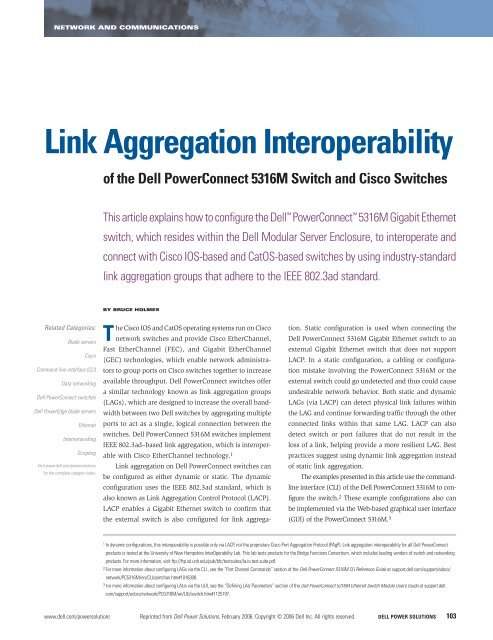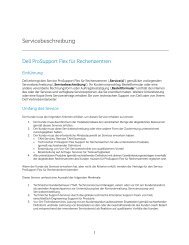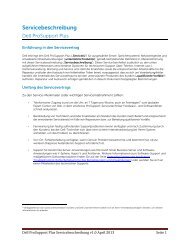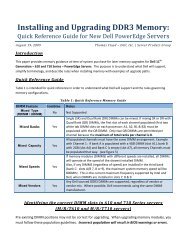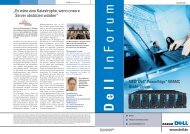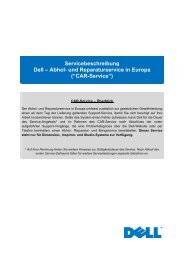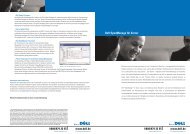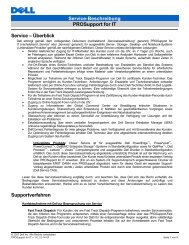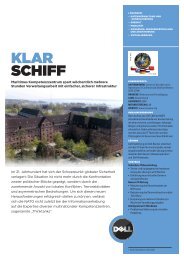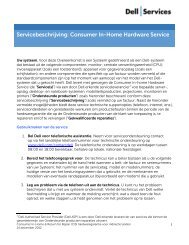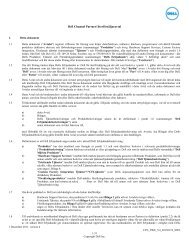Link Aggregation Interoperability of the Dell PowerConnect 5316M
Link Aggregation Interoperability of the Dell PowerConnect 5316M
Link Aggregation Interoperability of the Dell PowerConnect 5316M
Create successful ePaper yourself
Turn your PDF publications into a flip-book with our unique Google optimized e-Paper software.
NETWORK AND COMMUNICATIONS<br />
<strong>Link</strong> <strong>Aggregation</strong> <strong>Interoperability</strong><br />
Related Categories:<br />
Blade servers<br />
Cisco<br />
Command line interface (CLI)<br />
Data networking<br />
<strong>Dell</strong> <strong>PowerConnect</strong> switches<br />
<strong>Dell</strong> PowerEdge blade servers<br />
E<strong>the</strong>rnet<br />
Internetworking<br />
Scripting<br />
Visit www.dell.com/powersolutions<br />
for <strong>the</strong> complete category index.<br />
<strong>of</strong> <strong>the</strong> <strong>Dell</strong> <strong>PowerConnect</strong> <strong>5316M</strong> Switch and Cisco Switches<br />
This article explains how to configure <strong>the</strong> <strong>Dell</strong> <strong>PowerConnect</strong> <strong>5316M</strong> Gigabit E<strong>the</strong>rnet<br />
switch, which resides within <strong>the</strong> <strong>Dell</strong> Modular Server Enclosure, to interoperate and<br />
connect with Cisco IOS-based and CatOS-based switches by using industry-standard<br />
link aggregation groups that adhere to <strong>the</strong> IEEE 802.3ad standard.<br />
BY BRUCE HOLMES<br />
The Cisco IOS and CatOS operating systems run on Cisco<br />
network switches and provide Cisco E<strong>the</strong>rChannel,<br />
Fast E<strong>the</strong>rChannel (FEC), and Gigabit E<strong>the</strong>rChannel<br />
(GEC) technologies, which enable network administrators<br />
to group ports on Cisco switches toge<strong>the</strong>r to increase<br />
available throughput. <strong>Dell</strong> <strong>PowerConnect</strong> switches <strong>of</strong>fer<br />
a similar technology known as link aggregation groups<br />
(LAGs), which are designed to increase <strong>the</strong> overall bandwidth<br />
between two <strong>Dell</strong> switches by aggregating multiple<br />
ports to act as a single, logical connection between <strong>the</strong><br />
switches. <strong>Dell</strong> <strong>PowerConnect</strong> <strong>5316M</strong> switches implement<br />
IEEE 802.3ad–based link aggregation, which is interoperable<br />
with Cisco E<strong>the</strong>rChannel technology. 1<br />
<strong>Link</strong> aggregation on <strong>Dell</strong> <strong>PowerConnect</strong> switches can<br />
be configured as ei<strong>the</strong>r dynamic or static. The dynamic<br />
configuration uses <strong>the</strong> IEEE 802.3ad standard, which is<br />
also known as <strong>Link</strong> <strong>Aggregation</strong> Control Protocol (LACP).<br />
LACP enables a Gigabit E<strong>the</strong>rnet switch to confirm that<br />
<strong>the</strong> external switch is also configured for link aggrega-<br />
tion. Static configuration is used when connecting <strong>the</strong><br />
<strong>Dell</strong> <strong>PowerConnect</strong> <strong>5316M</strong> Gigabit E<strong>the</strong>rnet switch to an<br />
external Gigabit E<strong>the</strong>rnet switch that does not support<br />
LACP. In a static configuration, a cabling or configuration<br />
mistake involving <strong>the</strong> <strong>PowerConnect</strong> <strong>5316M</strong> or <strong>the</strong><br />
external switch could go undetected and thus could cause<br />
undesirable network behavior. Both static and dynamic<br />
LAGs (via LACP) can detect physical link failures within<br />
<strong>the</strong> LAG and continue forwarding traffic through <strong>the</strong> o<strong>the</strong>r<br />
connected links within that same LAG. LACP can also<br />
detect switch or port failures that do not result in <strong>the</strong><br />
loss <strong>of</strong> a link, helping provide a more resilient LAG. Best<br />
practices suggest using dynamic link aggregation instead<br />
<strong>of</strong> static link aggregation.<br />
The examples presented in this article use <strong>the</strong> commandline<br />
interface (CLI) <strong>of</strong> <strong>the</strong> <strong>Dell</strong> <strong>PowerConnect</strong> <strong>5316M</strong> to configure<br />
<strong>the</strong> switch. 2 These example configurations also can<br />
be implemented via <strong>the</strong> Web-based graphical user interface<br />
(GUI) <strong>of</strong> <strong>the</strong> <strong>PowerConnect</strong> <strong>5316M</strong>. 3<br />
1 In dynamic configurations, this interoperability is possible only via LACP, not <strong>the</strong> proprietary Cisco Port <strong>Aggregation</strong> Protocol (PAgP). <strong>Link</strong> aggregation interoperability for all <strong>Dell</strong> <strong>PowerConnect</strong><br />
products is tested at <strong>the</strong> University <strong>of</strong> New Hampshire InterOperability Lab. This lab tests products for <strong>the</strong> Bridge Functions Consortium, which includes leading vendors <strong>of</strong> switch and networking<br />
products. For more information, visit ftp://ftp.iol.unh.edu/pub/bfc/testsuites/la.io.test.suite.pdf.<br />
2 For more information about configuring LAGs via <strong>the</strong> CLI., see <strong>the</strong> “Port Channel Commands” section <strong>of</strong> <strong>the</strong> <strong>Dell</strong> <strong>PowerConnect</strong> <strong>5316M</strong> CLI Reference Guide e at support.dell.com/support/edocs/<br />
network/PC<strong>5316M</strong>/en/CLI/portchan.htm#1016308.<br />
3 For more information about configuring LAGs via <strong>the</strong> GUI, see <strong>the</strong> “Defining LAG Parameters” section <strong>of</strong> <strong>the</strong> <strong>Dell</strong> <strong>PowerConnect</strong> <strong>5316M</strong> E<strong>the</strong>rnet Switch Module User’s Guide e at support.dell.<br />
com/support/edocs/network/PC<strong>5316M</strong>/en/UG/switch.htm#1125197.<br />
www.dell.com/powersolutions Reprinted from <strong>Dell</strong> Power Solutions, February 2006. Copyright © 2006 <strong>Dell</strong> Inc. All rights reserved. DELL POWER SOLUTIONS 103
NETWORK AND COMMUNICATIONS<br />
<strong>Link</strong> aggregation with Gigabit E<strong>the</strong>rnet switches<br />
The following examples show minimal configurations necessary<br />
to establish a LAG between a Cisco IOS-based Gigabit E<strong>the</strong>r-<br />
net switch (Catalyst 3750), Cisco CatOS-based E<strong>the</strong>rnet switch<br />
(Catalyst 6509), and <strong>the</strong> <strong>Dell</strong> <strong>PowerConnect</strong> <strong>5316M</strong> Gigabit<br />
E<strong>the</strong>rnet switch. These commands should work properly when<br />
using <strong>the</strong> default configuration <strong>of</strong> each switch. Note: These com-<br />
mands will erase any configuration data previously configured<br />
and reboot <strong>the</strong> switch.<br />
104<br />
To set <strong>the</strong> <strong>Dell</strong> <strong>PowerConnect</strong> <strong>5316M</strong> to <strong>the</strong> default configura-<br />
tion, administrators should issue <strong>the</strong> following commands:<br />
<strong>5316M</strong># delete startup-config<br />
<strong>5316M</strong># reload<br />
To set <strong>the</strong> Cisco IOS-based Catalyst 3750 switch to <strong>the</strong> default<br />
configuration, administrators should issue <strong>the</strong> following com-<br />
mands:<br />
3750# delete flash:/config.text<br />
3750# reload<br />
To set <strong>the</strong> Cisco CatOS-based Catalyst 6509 switch to <strong>the</strong><br />
default configuration, administrators should issue <strong>the</strong> following<br />
commands:<br />
Cat_6509 (enable) clear config all<br />
Please see <strong>the</strong> “Configuration limitations” section in this article<br />
for scenarios in which resetting <strong>the</strong> switches to factory defaults<br />
would be impractical.<br />
The <strong>Dell</strong> <strong>PowerConnect</strong> <strong>5316M</strong> can support up to eight LAGs.<br />
A port channel can have from zero to six <strong>of</strong> <strong>the</strong> external ports as<br />
members. Internal ports cannot be members <strong>of</strong> a LAG. The examples<br />
in this article use different numbers <strong>of</strong> ports in a LAG.<br />
Best practices recommend that <strong>the</strong> ports to be aggregated on<br />
both <strong>the</strong> Cisco and <strong>Dell</strong> switches be disconnected during configu-<br />
ration. This will avoid any network loops being formed before <strong>the</strong><br />
LAG is set up.<br />
Configuring <strong>the</strong> <strong>PowerConnect</strong> <strong>5316M</strong> external ports<br />
for dynamic link aggregation<br />
The following example shows <strong>the</strong> <strong>Dell</strong> <strong>PowerConnect</strong> <strong>5316M</strong> CLI<br />
commands for configuring <strong>the</strong> six external ports on <strong>the</strong> Gigabit<br />
E<strong>the</strong>rnet switch for LACP:<br />
<strong>5316M</strong>(config)# interface range e<strong>the</strong>rnet g11-16<br />
<strong>5316M</strong>(config-if)# channel-group 1 mode auto<br />
The first command sets <strong>the</strong> CLI mode to configure <strong>the</strong> six exter-<br />
nal Gigabit E<strong>the</strong>rnet ports (referred to in <strong>the</strong> command as g11-16,<br />
which represents Gigabit E<strong>the</strong>rnet ports 11 through 16). All 6 ports<br />
do not have to be selected; a LAG can have from zero to six ports,<br />
depending on <strong>the</strong> requirements <strong>of</strong> <strong>the</strong> network. The number <strong>of</strong> ports<br />
in <strong>the</strong> LAG correlates to <strong>the</strong> amount <strong>of</strong> bandwidth and redundancy<br />
achievable in <strong>the</strong> network—that is, <strong>the</strong> more ports, <strong>the</strong> more band-<br />
width and redundancy. A LAG can even be configured without any<br />
member ports. When ports are added to <strong>the</strong> LAG, <strong>the</strong>y will be set<br />
to <strong>the</strong> configuration <strong>of</strong> <strong>the</strong> LAG.<br />
The second command aggregates <strong>the</strong> six ports into a LAG<br />
(referred to in <strong>the</strong> command as channel-group), which will<br />
use LACP (referred to in <strong>the</strong> command as mode auto). The<br />
channel-group number, which is 1 in this example, has meaning<br />
only within <strong>the</strong> switch and is used to differentiate up to eight<br />
unique channel-groups. For each LAG created, administrators<br />
must designate it with a number between one and eight for up<br />
to eight groups. Only <strong>the</strong> external ports (11 through 16) can be<br />
part <strong>of</strong> a LAG.<br />
Configuring a Cisco IOS-based Gigabit E<strong>the</strong>rnet switch<br />
for dynamic link aggregation<br />
The following example shows <strong>the</strong> Cisco IOS-based switch CLI com-<br />
mands for configuring six ports for LACP:<br />
3750(config)# interface range GigabitE<strong>the</strong>rnet<br />
1/0/1 - 6<br />
3750(config-if)# channel-protocol lacp<br />
3750(config-if)# channel-group 1 mode active<br />
The first command sets <strong>the</strong> CLI mode to configure six Gigabit<br />
E<strong>the</strong>rnet ports (referred to in <strong>the</strong> command as GigabitE<strong>the</strong>rnet<br />
1/0/1 – 6, which represents Gigabit E<strong>the</strong>rnet ports 1 through 6).<br />
The second command sets ports to use LACP as <strong>the</strong> LAG protocol<br />
(and not PAgP). The third command aggregates <strong>the</strong> six ports into<br />
a LAG (referred to in <strong>the</strong> command as channel-group), which<br />
will use LACP (referred to in <strong>the</strong> command as mode active). The<br />
channel-group number, which is 1 in this example, has mean-<br />
ing only within <strong>the</strong> switch and is used to differentiate unique<br />
channel-groups.<br />
Configuring a Cisco CatOS-based Gigabit E<strong>the</strong>rnet switch<br />
for dynamic link aggregation<br />
The following example shows <strong>the</strong> Cisco CatOS-based switch CLI<br />
commands for configuring six ports for LACP:<br />
Cat_6509(enable) set channelprotocol lacp 2<br />
Cat_6509(enable) set port lacp-channel 2/1-6<br />
mode active<br />
DELL POWER SOLUTIONS Reprinted from <strong>Dell</strong> Power Solutions, February 2006. Copyright © 2006 <strong>Dell</strong> Inc. All rights reserved. February 2006
<strong>5316M</strong># show interfaces port-channel 1<br />
Channel Ports<br />
....... .....<br />
ch1 Active: g(11-16)<br />
Figure 1. Using <strong>the</strong> show interfaces command to confirm a LAG connection for <strong>the</strong><br />
<strong>Dell</strong> <strong>PowerConnect</strong> <strong>5316M</strong><br />
The first command sets <strong>the</strong> LAG dynamic protocol to LACP on<br />
module 2 (in this example, this module in <strong>the</strong> switch is used to vali-<br />
date <strong>the</strong> examples in this article; o<strong>the</strong>r switches may be configured<br />
differently). The second command aggregates six ports on module 2<br />
(referred to in <strong>the</strong> command as 2/1–6, which represents ports 1<br />
through 6 on module 2) into a LAG (referred to in <strong>the</strong> command as<br />
lacp-channel), which will use LACP (referred to in <strong>the</strong> command<br />
as mode active).<br />
Note: Only <strong>the</strong> “active” Cisco mode is supported for LACP<br />
interoperability with <strong>the</strong> <strong>Dell</strong> <strong>PowerConnect</strong> <strong>5316M</strong>. The o<strong>the</strong>r<br />
modes (“passive,” “auto,” “on,” and “desirable”) should not<br />
be used when using LACP between a Cisco switch and <strong>the</strong><br />
<strong>PowerConnect</strong> <strong>5316M</strong>. This is a common configuration error.<br />
Confirming a successful dynamic link aggregation<br />
connection with <strong>the</strong> <strong>PowerConnect</strong> <strong>5316M</strong><br />
Figure 1 provides an example usage <strong>of</strong> <strong>the</strong> show interfaces<br />
command, which can be issued to help ensure that <strong>the</strong> <strong>Dell</strong><br />
<strong>PowerConnect</strong> <strong>5316M</strong> switch has established a LAG and that <strong>the</strong><br />
LAG is connected. The output <strong>of</strong> this command shows that ports<br />
11 through 16 are active. This confirms that <strong>the</strong>re is physical link<br />
on all ports in <strong>the</strong> LAG and that <strong>the</strong> <strong>PowerConnect</strong> <strong>5316M</strong> has<br />
communicated with <strong>the</strong> Cisco switch to successfully establish an<br />
aggregated link on ports 11 through 16 with LACP.<br />
Confirming a successful dynamic link aggregation<br />
connection with Cisco IOS<br />
Figure 2 provides an example <strong>of</strong> <strong>the</strong> Cisco IOS show interfaces<br />
command, which can be used to help ensure that <strong>the</strong> Cisco IOS-<br />
based switch has established a LAG and that <strong>the</strong> LAG is connected.<br />
The output <strong>of</strong> this command shows that ports 1/0/1 through 1/0/6<br />
are active. This confirms that <strong>the</strong>re is physical link on all ports in<br />
<strong>the</strong> LAG and that <strong>the</strong> Cisco switch has communicated with <strong>the</strong><br />
<strong>PowerConnect</strong> <strong>5316M</strong> switch to successfully establish an aggregated<br />
link on ports 1/0/1 through 1/0/6 with LACP.<br />
Confirming a successful dynamic link aggregation<br />
connection with Cisco CatOS<br />
Figure 3 provides an example usage <strong>of</strong> <strong>the</strong> Cisco CatOS show<br />
lacp-channel info command, which can be used to help ensure<br />
NETWORK AND COMMUNICATIONS<br />
that <strong>the</strong> Cisco CatOS-based switch has established a LAG and<br />
that <strong>the</strong> LAG is connected. The output <strong>of</strong> this command shows<br />
that <strong>the</strong> status <strong>of</strong> ports 2/1 through 2/6 is “connected” and<br />
<strong>the</strong> channel mode <strong>of</strong> <strong>the</strong>se ports is “active.” This confirms that<br />
<strong>the</strong>re is physical link on all ports in <strong>the</strong> LAG and that <strong>the</strong> Cisco<br />
switch has communicated with <strong>the</strong> <strong>PowerConnect</strong> <strong>5316M</strong> switch<br />
to successfully establish an aggregated link on ports 2/1 through<br />
2/6 with LACP.<br />
Configuring <strong>the</strong> <strong>PowerConnect</strong> <strong>5316M</strong> external ports<br />
for static link aggregation<br />
The following example shows <strong>the</strong> <strong>Dell</strong> <strong>PowerConnect</strong> <strong>5316M</strong> CLI<br />
commands for configuring three external ports <strong>of</strong> <strong>the</strong> Gigabit Eth-<br />
ernet switch for static aggregation:<br />
<strong>5316M</strong>(config)# interface range e<strong>the</strong>rnet g13-15<br />
<strong>5316M</strong>(config-if)# channel-group 1 mode on<br />
Note that a LAG can be configured with zero to six ports (this<br />
example uses three ports), but a port can be part <strong>of</strong> only a single<br />
LAG. The first command sets <strong>the</strong> CLI mode to configure three exter-<br />
nal Gigabit E<strong>the</strong>rnet ports (13 through 15). The second command<br />
aggregates <strong>the</strong> three ports into a static LAG. Static LAGs do not use<br />
LACP and are defined in <strong>the</strong> CLI by setting <strong>the</strong> channel-group mode<br />
to “on.” The channel-group number, which is 1 in this example,<br />
3750# show interfaces port-channel 1 e<strong>the</strong>rchannel<br />
Port-channel1 (Primary aggregator)<br />
Age <strong>of</strong> <strong>the</strong> Port-channel = 00d:01h:11m:34s<br />
Logical slot/port = 10/1<br />
Number <strong>of</strong> ports = 6<br />
HotStandBy port = null<br />
Port state = Port-channel Ag-Inuse<br />
Protocol = LACP<br />
Ports in <strong>the</strong> Port-channel:<br />
Index Load Port EC state No <strong>of</strong> bits<br />
------+------+---------+------------+------------<br />
0 00 Gi1/0/1 Active 0<br />
0 00 Gi1/0/2 Active 0<br />
0 00 Gi1/0/3 Active 0<br />
0 00 Gi1/0/4 Active 0<br />
0 00 Gi1/0/5 Active 0<br />
0 00 Gi1/0/6 Active 0<br />
Figure 2. Using <strong>the</strong> show interfaces command to confirm a LAG connection for a<br />
Cisco IOS-based switch<br />
www.dell.com/powersolutions Reprinted from <strong>Dell</strong> Power Solutions, February 2006. Copyright © 2006 <strong>Dell</strong> Inc. All rights reserved. DELL POWER SOLUTIONS 105
NETWORK AND COMMUNICATIONS<br />
106<br />
Cat_6509> (enable) show lacp-channel info<br />
Chan Port Status Channel Admin Speed Duplex Vlan<br />
id mode group<br />
---- ----- ---------- --------- ----- ----- ------ ----<br />
801 2/1 connected active 395 a-1Gb a-full 1<br />
801 2/2 connected active 395 a-1Gb a-full 1<br />
801 2/3 connected active 395 a-1Gb a-full 1<br />
801 2/4 connected active 395 a-1Gb a-full 1<br />
801 2/5 connected active 395 a-1Gb a-full 1<br />
801 2/6 connected active 395 a-1Gb a-full 1<br />
has meaning only within <strong>the</strong> switch and is used to differentiate up<br />
to eight unique channel-groups. For each LAG created, administra-<br />
tors must designate it with a number between one and eight for<br />
up to eight groups. The internal ports that connect to <strong>the</strong> servers<br />
do not support LAGs.<br />
Configuring a Cisco IOS-based switch for static link aggregation<br />
The following example shows <strong>the</strong> Cisco IOS CLI commands<br />
for configuring three ports <strong>of</strong> <strong>the</strong> Cisco switch for static link<br />
aggregation:<br />
3750(config)# interface range GigabitE<strong>the</strong>rnet<br />
1/0/9 - 11<br />
. . .<br />
Figure 3. Using <strong>the</strong> show lacp-channel info command to confirm a LAG connection for a Cisco<br />
CatOS-based switch<br />
3750(config-if)# channel-group 1 mode on<br />
The first command sets <strong>the</strong> CLI mode to configure three Gigabit<br />
E<strong>the</strong>rnet ports (1/0/9 through 1/0/11). The second command<br />
aggregates <strong>the</strong> three ports into a static LAG. Static LAGs do not<br />
use LACP and are defined in <strong>the</strong> Cisco CLI by setting <strong>the</strong> channel-<br />
group mode to “on.” The channel-group number, which is 1 in<br />
this example, has meaning only within <strong>the</strong> switch and is used to<br />
differentiate channel-groups. The number <strong>of</strong> channel-groups sup-<br />
ported by Cisco switches depends on <strong>the</strong> switch model.<br />
Configuring a Cisco CatOS-based switch for static link<br />
aggregation<br />
The Cisco CatOS CLI allows <strong>the</strong> configuration <strong>of</strong> static LAGs via<br />
LACP or PAgP commands. The following example shows <strong>the</strong> Cisco<br />
CatOS CLI LACP channelprotocol commands for configuring three<br />
ports <strong>of</strong> <strong>the</strong> Cisco switch for static link aggregation:<br />
Cat_6509(enable) set channelprotocol lacp 2<br />
Cat_6509(enable) set port lacp-channel 2/9-11 mode on<br />
The first command sets module 2 to use <strong>the</strong> LACP<br />
commands to configure LAGs. Because a static LAG is<br />
being defined, <strong>the</strong> setting for <strong>the</strong> channelprotocol com-<br />
mand does not matter. The second command configures<br />
<strong>the</strong> three E<strong>the</strong>rnet ports (2/9 through 2/11) into a static<br />
LAG. Static LAGs do not use LACP and are defined in <strong>the</strong><br />
Cisco CLI by setting <strong>the</strong> lacp-channel mode to “on.”<br />
The following example shows <strong>the</strong> Cisco CatOS CLI<br />
PAgP channelprotocol commands for configuring three<br />
ports <strong>of</strong> <strong>the</strong> Cisco switch for static link aggregation using<br />
<strong>the</strong> PAgP command:<br />
Cat_6509(enable) set channelprotocol pagp 2<br />
Cat_6509(enable) set port channel 2/9-11<br />
mode on<br />
The first command sets module 2 to use <strong>the</strong> PaGP com-<br />
mands to configure LAGs. As mentioned before, <strong>the</strong> setting for <strong>the</strong><br />
channelprotocol command does not matter because a static<br />
LAG is being defined. The second command configures <strong>the</strong> three<br />
E<strong>the</strong>rnet ports (2/9 through 2/11) into a static LAG. Static LAGs<br />
do not use PAgP and are defined in <strong>the</strong> Cisco CLI by setting <strong>the</strong><br />
channel mode to “on.”<br />
Confirming a successful static link aggregation connection<br />
When LACP is not being used, only careful inspection <strong>of</strong> <strong>the</strong> Cisco<br />
and <strong>PowerConnect</strong> <strong>5316M</strong> configurations can confirm that a static<br />
LAG has been established. Administrators can take <strong>the</strong> following<br />
steps to help confirm <strong>the</strong> connection:<br />
1. Check that <strong>the</strong> cabling is connected to <strong>the</strong> correct ports on<br />
both switches.<br />
2. Check that all <strong>the</strong> LAG ports have a link.<br />
3. Use <strong>the</strong> show running-config command to confirm that <strong>the</strong><br />
desired ports are in <strong>the</strong> LAG:<br />
• <strong>PowerConnect</strong> <strong>5316M</strong>: <strong>5316M</strong># show running-config<br />
• Catalyst 3750: 3750# show running-config<br />
• Catalyst 6509: Cat_6509(enable) show running-config<br />
<strong>Link</strong> aggregation with Cisco Fast E<strong>the</strong>rnet switches<br />
Some enterprise IT organizations use Cisco Fast E<strong>the</strong>rnet (100 Mbps)<br />
network switches. In this case, <strong>the</strong>y may not want to incur <strong>the</strong><br />
expenses to replace <strong>the</strong> Cisco Fast E<strong>the</strong>rnet switches to match <strong>the</strong><br />
high speed <strong>of</strong> <strong>the</strong> <strong>Dell</strong> <strong>PowerConnect</strong> <strong>5316M</strong> Gigabit E<strong>the</strong>rnet switch,<br />
but <strong>the</strong>y probably still want to achieve <strong>the</strong> most bandwidth possible.<br />
Because <strong>the</strong> <strong>PowerConnect</strong> <strong>5316M</strong> switch supports auto-negotiation,<br />
administrators do not need to perform any additional steps to connect<br />
aggregated links to a Cisco Fast E<strong>the</strong>rnet switch if <strong>the</strong> Cisco switch’s<br />
link aggregation ports are also set to auto-negotiation.<br />
DELL POWER SOLUTIONS Reprinted from <strong>Dell</strong> Power Solutions, February 2006. Copyright © 2006 <strong>Dell</strong> Inc. All rights reserved. February 2006
The ports in a <strong>Dell</strong> <strong>PowerConnect</strong> <strong>5316M</strong> LAG are set to auto-<br />
negotiation by default. If <strong>the</strong> negotiation setting <strong>of</strong> <strong>the</strong> LAG has been<br />
changed because <strong>of</strong> a previous switch configuration, administra-<br />
tors can use <strong>the</strong> following command to set <strong>the</strong> LAG ports back to<br />
auto-negotiation:<br />
<strong>5316M</strong>(config)# interface port-channel 1<br />
<strong>5316M</strong>(config-if)# negotiation<br />
To set <strong>the</strong> ports on a Cisco IOS-based switch to auto-negotiation,<br />
administrators can use <strong>the</strong> following commands:<br />
2950(config)# interface range FastE<strong>the</strong>rnet 0/1 - 3<br />
2950(config-if)# speed auto<br />
2950(config-if)# duplex auto<br />
To set <strong>the</strong> ports on a Cisco CatOS-based switch to auto-negotiation,<br />
administrators can use <strong>the</strong> following command:<br />
Cat_6509> (enable) set port speed 2/9-11 auto<br />
If auto-negotiation cannot be used, both <strong>the</strong> <strong>Dell</strong> <strong>PowerConnect</strong><br />
LAG and <strong>the</strong> Cisco switch ports in <strong>the</strong> LAG must be set to <strong>the</strong> same<br />
speed and duplex. Intermittent link failures may occur if one switch<br />
is in auto-negotiation mode and <strong>the</strong> o<strong>the</strong>r is forced to a certain<br />
speed and duplex.<br />
The <strong>Dell</strong> <strong>PowerConnect</strong> <strong>5316M</strong> LAG can be forced to 100 Mbps<br />
with <strong>the</strong> following commands:<br />
<strong>5316M</strong>(config)# interface port-channel 1<br />
<strong>5316M</strong>(config-if)# no negotiation<br />
<strong>5316M</strong>(config-if)# speed 100<br />
In this example, <strong>the</strong> LAG is referred to in <strong>the</strong> command as<br />
port-channel 1. The no negotiation command means<br />
that <strong>the</strong>re is no auto-negotiation on <strong>the</strong> ports in <strong>the</strong> LAG. The<br />
speed 100 command specifies all <strong>the</strong> ports in <strong>the</strong> LAG to be 100<br />
Mbps. Because this is a LAG configuration, and <strong>the</strong> 802.3ad stan-<br />
dard requires all ports in a LAG to be full duplex, administrator do<br />
not need to set <strong>the</strong> duplex to full (and in fact, cannot do so via<br />
<strong>the</strong> <strong>PowerConnect</strong> <strong>5316M</strong> CLI). The duplex is set to full by default<br />
on LAG ports.<br />
Note: This process differs from <strong>the</strong> Cisco IOS and CatOS<br />
methods, which require that all <strong>the</strong> ports in <strong>the</strong> LAG be config-<br />
ured to 100 Mbps and full duplex ra<strong>the</strong>r than setting <strong>the</strong> LAG to<br />
100 Mbps. Configuring all ports in a LAG to 100 Mbps and full<br />
duplex on <strong>the</strong> <strong>Dell</strong> <strong>PowerConnect</strong> <strong>5316M</strong> switch would have no<br />
effect because <strong>the</strong> LAG configuration takes precedence over indi-<br />
vidual port configurations.<br />
NETWORK AND COMMUNICATIONS<br />
Administrators can use <strong>the</strong> following commands to set <strong>the</strong> ports<br />
on <strong>the</strong> Cisco IOS-based switch to 100 Mbps and full duplex:<br />
2950(config)# interface range FastE<strong>the</strong>rnet 0/1 - 3<br />
2950(config-if)# speed 100<br />
2950(config-if)# duplex full<br />
Administrators can use <strong>the</strong> following commands to set<br />
<strong>the</strong> ports on <strong>the</strong> Cisco CatOS-based switch to 100 Mbps and<br />
full duplex:<br />
Cat_6509> (enable) set port speed 2/9-11 100<br />
Cat_6509> (enable) set port duplex 2/9-11 full<br />
Configuration limitations<br />
Ports to be aggregated must be configured so that <strong>the</strong>y are com-<br />
patible with <strong>the</strong> link aggregation feature and with <strong>the</strong> switch to<br />
which <strong>the</strong>y will be connected. For <strong>the</strong> <strong>Dell</strong> <strong>PowerConnect</strong> <strong>5316M</strong>,<br />
<strong>the</strong> following limitations apply to aggregated ports (<strong>the</strong> commands<br />
to remove <strong>the</strong> configuration are shown immediately after each<br />
limitation):<br />
• The port cannot have an IP address defined on it:<br />
<strong>5316M</strong>(config)# interface E<strong>the</strong>rnet g11<br />
<strong>5316M</strong>(config-if)# no ip address<br />
• The port cannot belong to ano<strong>the</strong>r LAG:<br />
<strong>5316M</strong>(config)# interface E<strong>the</strong>rnet g11<br />
<strong>5316M</strong>(config-if)# no channel-group<br />
• The port cannot be a mirrored port:<br />
<strong>5316M</strong>(config)# interface E<strong>the</strong>rnet g11<br />
<strong>5316M</strong>(config-if)# no port monitor gxx<br />
• The port cannot have GARP (Generic Attributes Registration<br />
Protocol) VLAN (virtual LAN) Registration Protocol (GVRP)<br />
enabled:<br />
<strong>5316M</strong>(config)# interface E<strong>the</strong>rnet g11<br />
<strong>5316M</strong>(config-if)# no gvrp enable<br />
• The port cannot belong to an access VLAN o<strong>the</strong>r than <strong>the</strong><br />
default VLAN (1):<br />
<strong>5316M</strong>(config)# interface E<strong>the</strong>rnet g11<br />
<strong>5316M</strong>(config-if)# no switchport access vlan<br />
• The port cannot belong to a trunk VLAN o<strong>the</strong>r than <strong>the</strong><br />
default VLAN (1):<br />
<strong>5316M</strong>(config)# interface E<strong>the</strong>rnet g11<br />
<strong>5316M</strong>(config-if)# no switchport trunk native vlan<br />
www.dell.com/powersolutions Reprinted from <strong>Dell</strong> Power Solutions, February 2006. Copyright © 2006 <strong>Dell</strong> Inc. All rights reserved. DELL POWER SOLUTIONS 107
NETWORK AND COMMUNICATIONS<br />
108<br />
<strong>5316M</strong>(config-if)# exit<br />
<strong>5316M</strong>(config)# exit<br />
<strong>5316M</strong># show running-config<br />
interface range e<strong>the</strong>rnet g(13-16)<br />
channel-group 1 mode on<br />
exit<br />
interface e<strong>the</strong>rnet g11<br />
gvrp enable<br />
exit<br />
Figure 4. Example output for <strong>the</strong> show running-config command showing GVRP enabled<br />
<strong>5316M</strong># show running-config<br />
interface port-channel 1<br />
speed 100<br />
no negotiation<br />
exit<br />
interface e<strong>the</strong>rnet g11<br />
speed 10<br />
no negotiation<br />
exit<br />
interface range e<strong>the</strong>rnet g(11,13-16)<br />
channel-group 1 mode on<br />
exit<br />
Figure 5. Example output for <strong>the</strong> show running-config command showing differing<br />
LAG and port speeds<br />
• The internal switch ports (g1 through g10) cannot be part <strong>of</strong><br />
a LAG. The CLI will prevent adding internal ports to a LAG.<br />
To check <strong>the</strong> configuration <strong>of</strong> <strong>the</strong> ports on <strong>the</strong> <strong>PowerConnect</strong><br />
<strong>5316M</strong>, administrators can use <strong>the</strong> show running-config command<br />
and view <strong>the</strong> interface E<strong>the</strong>rnet gxx configurations, where xx<br />
indicates <strong>the</strong> port number. Figure 4 shows example output after this<br />
command has been issued. In this scenario, <strong>the</strong> no gvrp enable<br />
command would have to be issued on port g11 before this port<br />
could be added to a LAG.<br />
Cisco and <strong>Dell</strong> port configuration differences<br />
On <strong>the</strong> <strong>Dell</strong> <strong>PowerConnect</strong> <strong>5316M</strong>, configurations for <strong>the</strong> LAG<br />
take precedence over <strong>the</strong> configuration <strong>of</strong> <strong>the</strong> ports. In Figure 5,<br />
example output from <strong>the</strong> show running-config command<br />
shows that port g11 is actually set to 100 Mbps (and not 10 Mbps)<br />
because <strong>the</strong> LAG is set to 100 Mbps. If g11 is removed from <strong>the</strong><br />
LAG, <strong>the</strong> port configuration will be applied (that is, g11 would<br />
be set to 10 Mbps).<br />
On Cisco IOS- and CatOS-based switches, ports must be config-<br />
ured identically to be included in a LAG. Cisco IOS-based switches<br />
can use <strong>the</strong> “desirable” and “passive” mode options for <strong>the</strong> LAG<br />
setting. The <strong>PowerConnect</strong> <strong>5316M</strong> does not support this implemen-<br />
tation, and thus administrators should not use <strong>the</strong>se modes when<br />
configuring a LAG with a <strong>Dell</strong> <strong>PowerConnect</strong> switch. Instead, <strong>the</strong>y<br />
should use only <strong>the</strong> “active” mode (for LACP configuration) or <strong>the</strong><br />
“on” mode (for static configuration).<br />
Switches can control <strong>the</strong> distribution only <strong>of</strong> outgoing traffic<br />
on LAG ports. The <strong>PowerConnect</strong> <strong>5316M</strong> uses a static distribution<br />
method based on source and destination Media Access Control<br />
(MAC) addresses to decide which port or LAG a packet will<br />
travel through. 4<br />
Cisco IOS- and CatOS-based switches provide configuration<br />
options for changing <strong>the</strong> distribution <strong>of</strong> traffic on LAG ports. The<br />
Cisco IOS commands shown in Figure 6 can be used if <strong>the</strong> Cisco<br />
IOS-based switch performs poorly in <strong>the</strong> LAG. These commands<br />
allow administrators to configure <strong>the</strong> switch to distribute pack-<br />
ets to ports in a LAG based on <strong>the</strong> following settings: destina-<br />
tion IP address, destination E<strong>the</strong>rnet address, a combination <strong>of</strong><br />
source and destination IP addresses, a combination <strong>of</strong> source<br />
and destination E<strong>the</strong>rnet addresses, source IP address, or source<br />
E<strong>the</strong>rnet address.<br />
The Cisco CatOS commands shown in Figure 7 can be used if<br />
<strong>the</strong> Cisco CatOS-based switch performs poorly in <strong>the</strong> LAG. These<br />
commands allow administrators to configure <strong>the</strong> switch to dis-<br />
tribute packets to ports in a LAG based on <strong>the</strong> following settings:<br />
destination IP address, destination E<strong>the</strong>rnet address, a combination<br />
<strong>of</strong> source and destination IP addresses, a combination <strong>of</strong> source<br />
and destination E<strong>the</strong>rnet addresses, source IP address, or source<br />
E<strong>the</strong>rnet address.<br />
4 For an in-depth discussion <strong>of</strong> this algorithm and network design considerations, see “Network <strong>Link</strong> <strong>Aggregation</strong> Practices with <strong>the</strong> <strong>Dell</strong> PowerEdge 1855 Blade Server” by Bruce Holmes in <strong>Dell</strong> Power Solutions, May 2005;<br />
www.dell.com/downloads/global/power/ps2q05-20040286-Holmes-OE.pdf.<br />
3750(config)#port-channel load-balance dst-ip<br />
3750(config)#port-channel load-balance dst-mac<br />
3750(config)#port-channel load-balance src-dst-ip<br />
3750(config)#port-channel load-balance src-dst-mac<br />
3750(config)#port-channel load-balance src-ip<br />
3750(config)#port-channel load-balance src-mac<br />
Figure 6. Cisco IOS commands for configuring packet distribution in a LAG<br />
DELL POWER SOLUTIONS Reprinted from <strong>Dell</strong> Power Solutions, February 2006. Copyright © 2006 <strong>Dell</strong> Inc. All rights reserved. February 2006
Cat_6509> (enable) set port channel all distribution ip destination<br />
Cat_6509> (enable) set port channel all distribution mac destination<br />
Cat_6509> (enable) set port channel all distribution ip both<br />
Cat_6509> (enable) set port channel all distribution mac both<br />
Cat_6509> (enable) set port channel all distribution ip source<br />
Cat_6509> (enable) set port channel all distribution mac source<br />
Figure 7. Cisco CatOS commands for configuring packet distribution in a LAG<br />
<strong>Interoperability</strong> between <strong>Dell</strong><br />
and Cisco switches<br />
The standards-based link aggregation feature <strong>of</strong> <strong>the</strong> <strong>Dell</strong> <strong>PowerConnect</strong><br />
<strong>5316M</strong> Gigabit E<strong>the</strong>rnet switch is designed to interoperate easily<br />
with Cisco IOS- and CatOS-based switches. By understanding <strong>the</strong><br />
differences in <strong>the</strong> <strong>Dell</strong> <strong>PowerConnect</strong> <strong>5316M</strong> and Cisco CLIs and<br />
building on <strong>the</strong> examples presented in this article, system admin-<br />
istrators can help integrate <strong>the</strong> <strong>PowerConnect</strong> <strong>5316M</strong> switch into<br />
<strong>the</strong>ir Cisco-based networks.<br />
Bruce Holmes is a senior test engineer in <strong>the</strong> <strong>Dell</strong> <strong>PowerConnect</strong> Group.<br />
He has worked at <strong>Dell</strong> for two years and supports <strong>PowerConnect</strong> switches<br />
NETWORK AND COMMUNICATIONS<br />
in all phases <strong>of</strong> product development and testing. He has a B.S. in Electrical<br />
Engineering from The University <strong>of</strong> Texas at Austin.<br />
FOR MORE INFORMATION<br />
Holmes, Bruce. “Network <strong>Link</strong> <strong>Aggregation</strong> Practices with <strong>the</strong><br />
<strong>Dell</strong> PowerEdge 1855 Blade Server.” <strong>Dell</strong> Power Solutions,<br />
May 2005. www.dell.com/downloads/global/power/<br />
ps2q05-20040286-Holmes-OE.pdf<br />
<strong>Dell</strong> <strong>PowerConnect</strong> <strong>5316M</strong> E<strong>the</strong>rnet Switch Module<br />
User’s Guide:<br />
support.dell.com/support/edocs/network/PC<strong>5316M</strong>/en/UG<br />
www.dell.com/powersolutions Reprinted from <strong>Dell</strong> Power Solutions, February 2006. Copyright © 2006 <strong>Dell</strong> Inc. All rights reserved. DELL POWER SOLUTIONS 109


